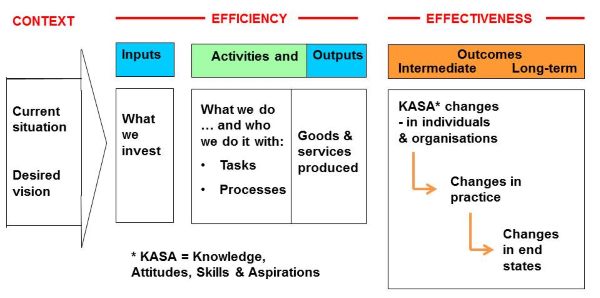More about outcomes – why they are important … and elusive!
This post looks more specifically at outcomes, and how they can be developed and written. It highlights the benefits of focusing on outcomes for project planning, implementation and evaluation. It also provides some tips and ideas for involving program staff and stakeholders in developing and working with outcome statements.
Until recently, the performance of many public sector programs has been judged largely on inputs, activities and outputs. Over recent years this approach has been increasingly questioned as being too concerned with efficiency considerations, without a corresponding focus on what benefits are actually arising from program funding and activities. Increasingly the trend is moving towards a focus on the specification and achievement of outcomes, revealing more about how effective programs are in achieving real development changes on-the-ground.
Outputs are the goods and services that result from activities. Outcomes are the constructive impacts on people or environments. In the past planning and evaluation has tended to focus on program outputs, or how we keep ourselves busy – the ‘what we do’ and ‘who we do it with’. This enables us to tell our partners, funders and stakeholders about what the program does, the services it provides, how it is unique, and who it serves. We can describe and count our activities and the different goods and services we produce. Now, however, we are being asked what difference it makes! This is a question about outcomes (see figure). Outcomes are the changes, benefits, learning or other effects that happen as a result of what the program offers or provides. Outcomes are usually specified in terms of either: i) social and organizational capacities (social outcomes – e.g. learning, understanding, perceptions, attitudes and behaviors), or ii) state conditions (the bio-physical, ecological, social or economic changes in a system).

While most people intuitively appreciate this distinction between outputs and outcomes, experience in results-oriented training sessions suggests that for many program staff, turning that appreciation into practice takes time. As the Keystone (2009) guide points out it takes most people quite a lot of conscious practice before they start thinking in terms of outcomes, rather than outputs or needs or activities. An outcome statement describes a result – a change that has taken place. It is not a needs statement, or an activity that is still in progress. Outputs comprise the products and activities that you do, while outcomes are what we see as a result of our outputs.) One simple test is to ask two questions of each statement: i) is it written as an outcome? and ii) does it describe changes that we can plausibly enable or facilitate in people, groups, institutions or environments?
Outcomes may be specified in different ways. Often a distinction is made between short-term, intermediate and long-term, or just intermediate and long-term. Short-term outcomes can be seen as the immediate difference that your program makes in the wider environment. A long-term outcome often has a number of short-term and intermediate outcomes that together contribute to the ultimate achievement of the long-term outcome. Collectively these outcomes should contribute explicitly to the wider vision underpinning program development. An intermediate outcome is a specified intermediate state that contributes to the desired long-term outcome – a step along the way. Intermediate outcomes are especially useful when time lags in measurable state outcomes are significant or limit timely response.
The program outcomes and intermediate outcomes should be structured in a logical hierarchy reflecting how each leads to another and/or contributes to the long-term community outcome(s). A useful way of doing this is to take each outcome and ask the question, ‘If we achieve this, what will it lead to and how will it contribute to the long-term outcome?’ Look for gaps – starting from the highest level outcome and working down the outcomes model. A test is being able to read an outcome and say, ‘Yes, this will likely be achieved if all of these initial (contributing intermediate) outcomes (and corresponding outputs) are achieved.’ The answers to these questions will enable you to draft a succinct statement of each outcome.
Each outcome statement should therefore define what will change as a result of an intervention and by how much (or, at the very least, in what direction the change will occur). This then allows the means of performance measurement to be defined. The more clearly an outcome statement specifies a desired change, the easier it is to define an appropriate indicator or indicator set.
It is not always easy to identify outcomes, and harder still to clarify them, but there are a number of key questions that can help. For example, begin by asking what is/will be different as a result of the initiative? For whom? What will be changed/improved? What do/will beneficiaries and other stakeholders say is the value of the program? For an existing program, look at the major activities. For each activity, ask yourself, ‘Why are we doing that?’ Usually, the answer to the ‘Why?’ question is an outcome. Most importantly, seek ideas and input from others. Their perspectives will help provide a broader understanding of the program and its benefits. This activity will also help build consensus among key program stakeholders.
When writing outcomes be sure to describe the desired change. Keep your outcomes SMART: Specific, Measurable, Achievable, Relevant, Time-limited. Say ‘what’, not ‘how’ – Establishing the means and plausibility of the ‘how’ is a later step. Consider whether outcomes are likely to be achieved in the program time frame.
Table 1 Examples of outcome statement structure from a range of sectors
| Who/what | Change/desired effect | In what | By when |
| Agricultural production | Increase | $ value | Over x years |
| Biodiversity (species) | Increase | Trend | Over x years |
| Public awareness of an issue | Increase | Extent | Over x years |
This post provides a short introduction to the language and concepts of outcomes. Links to a wealth of information, tips and guides from around the world can be found from the LfS Managing for outcomes: using logic modeling webpage.
An independent systems scientist, action research practitioner and evaluator, with 30 years of experience in sustainable development and natural resource management. He is particularly interested in the development of planning, monitoring and evaluation tools that are outcome focused, and contribute towards efforts that foster social learning, sustainable development and adaptive management.

0 Comments on “More about outcomes – why they are important … and elusive!”